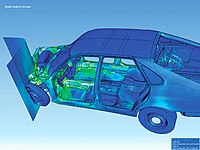
Photo from wikipedia
A goal of the Human Research Program at National Aeronautics and Space Administration (NASA) is to analyze and mitigate the risk of occupant injury due to dynamic loads. Experimental tests… Click to show full abstract
A goal of the Human Research Program at National Aeronautics and Space Administration (NASA) is to analyze and mitigate the risk of occupant injury due to dynamic loads. Experimental tests of human subjects and biofidelic anthropomorphic test devices provide valuable kinematic and kinetic data related to injury risk exposure. However, these experiments are expensive and time consuming compared to computational simulations of similar impact events. This study aimed to simulate human volunteer biodynamic response to unidirectional accelerative loading. Data from seven experimental studies involving 212 volunteer tests performed at the Air Force Research Laboratory were used to reconstruct 13 unique loading conditions across four different loading directions using finite element human body model (HBM) simulations. Acceleration pulses and boundary conditions from the experimental tests were applied to the Global Human Body Models Consortium (GHBMC) simplified 50th percentile male occupant (M50-OS) using the LS-Dyna finite element solver. Head acceleration, chest acceleration, and seat belt force traces were compared between the experimental and matched simulation signals using correlation and analysis (CORA) software and averaged into a comprehensive response score ranging from 0 to 1 with 1 representing a perfect match. The mean comprehensive response scores were 0.689 ± 0.018 (mean ± 1 standard deviation) in two frontal simulations, 0.683 ± 0.060 in four rear simulations, 0.676 ± 0.043 in five lateral simulations, and 0.774 ± 0.013 in two vertical simulations. The CORA scores for head and chest accelerations in these simulations exceeded mean scores reported in the original development and validation of the GHBMC M50-OS model. Collectively, the CORA scores indicated that the HBM in these boundary conditions closely replicated the kinematics of the human volunteers across all loading directions.
Journal Title: Annals of Biomedical Engineering
Year Published: 2018
Link to full text (if available)
Share on Social Media: Sign Up to like & get
recommendations!